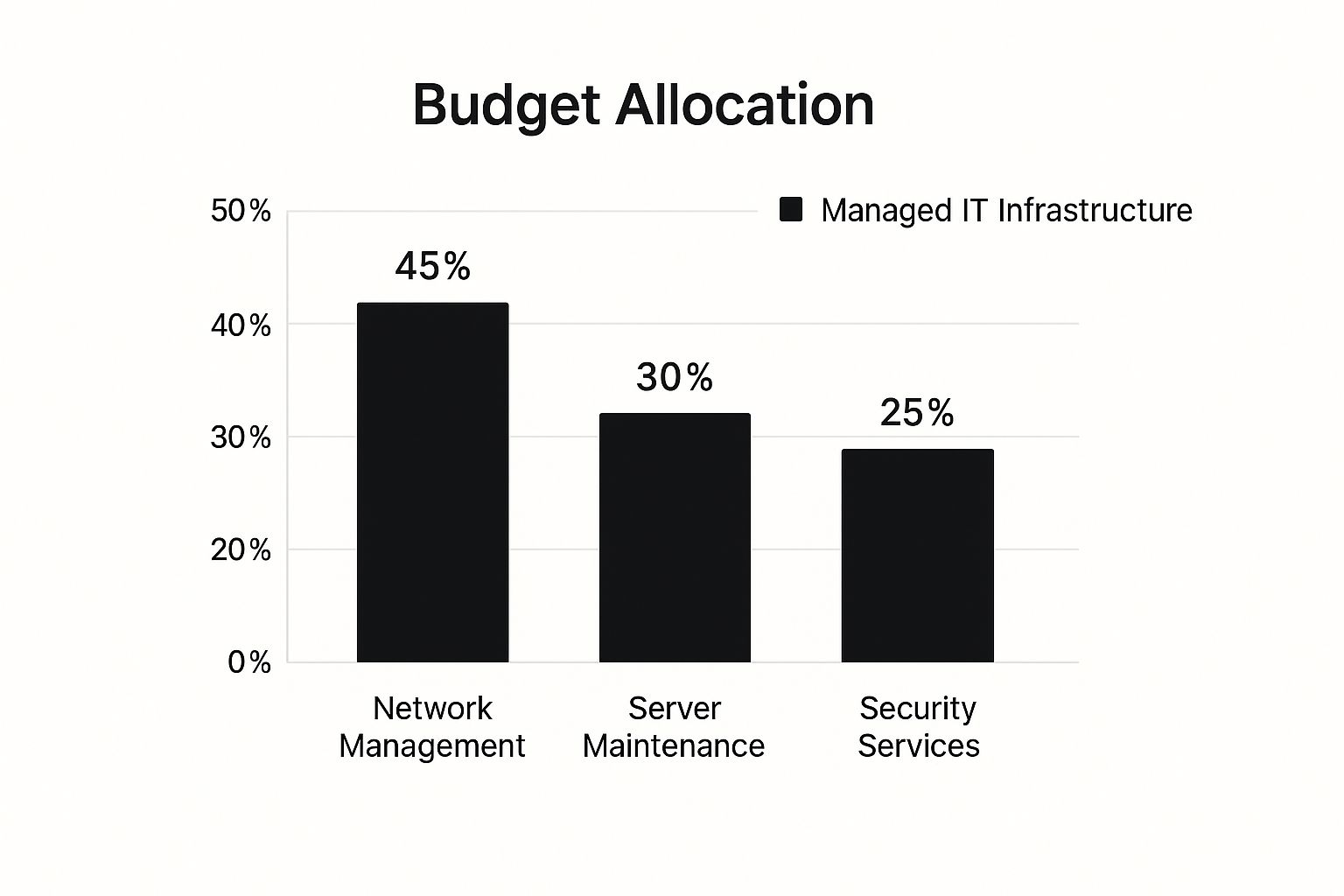The Evolution of Managed IT Infrastructure

Managed IT infrastructure has undergone a significant transformation. The focus has shifted from simply maintaining existing systems to strategically using technology to achieve core business objectives. This change recognizes that IT infrastructure is not just a cost, but a vital driver of innovation and growth.
Companies are now realizing a well-managed IT infrastructure can open doors to new markets, support the development of new products, and enhance customer service.
Several key factors have propelled this evolution. These include the growing complexity of technology, the increasing expense of in-house expertise, and the demand for greater agility and scalability.
From Reactive Maintenance to Proactive Management
Historically, many organizations treated IT infrastructure management as a reactive function, addressing problems only as they appeared. This reactive approach is no longer adequate in today’s dynamic business environment.
Organizations are now embracing a more proactive approach. The emphasis is on preventing problems before they impact operations. This shift involves implementing comprehensive monitoring and management tools like Datadog and developing proactive maintenance strategies.
Many organizations are turning to managed IT infrastructure providers to handle these complex tasks. This allows internal IT teams to focus on strategic projects, enabling businesses to be more agile and responsive to changing market dynamics. The increased demand for managed services underscores the importance of expert management for peak performance and robust security.
The Rise of Cloud Computing and Its Impact
A major force behind this evolution is the rise of cloud computing. Cloud technology has reshaped how businesses acquire and manage IT resources. It delivers greater flexibility, scalability, and cost-effectiveness compared to traditional on-premise infrastructure.
For example, companies can now easily adjust their IT resources to match demand without large capital expenditures on hardware. This scalability is particularly valuable for growing businesses needing to adapt quickly to market fluctuations.
The cloud has also given rise to new service models like Software-as-a-Service (SaaS) and Platform-as-a-Service (PaaS), further simplifying IT management. This allows businesses to concentrate on their core strengths, rather than managing the complexities of their IT infrastructure.
The managed IT infrastructure services market has experienced significant growth, driven by increasingly complex IT environments and the need for cost optimization. The market grew from $120.74 billion in 2024 to $134.37 billion in 2025, representing a CAGR of 11.3%. This growth is largely attributed to the widespread adoption of cloud technologies and ongoing digital transformation initiatives across diverse industries. For more detailed market statistics, visit: Learn more about the Managed IT Infrastructure Market. These developments highlight the growing strategic importance of IT infrastructure management for achieving business success.
Unlocking Business Advantages Through Managed IT Infrastructure
Managed IT infrastructure services offer significant advantages, empowering businesses to optimize their technology resources and achieve their strategic objectives. A key benefit is the transformation of unpredictable capital expenditures into predictable operational costs, offering much-appreciated budget stability. This shift allows for more effective resource allocation, enabling businesses to prioritize growth initiatives over unexpected IT issues. The following infographic details a typical budget allocation for managed IT infrastructure:

As shown, network management generally receives the largest budget allocation, followed by server maintenance and then security services. This distribution underscores the critical importance of network stability and performance for supporting daily operations. Partnering with a managed IT infrastructure provider also grants companies access to specialized expertise without the expense of hiring full-time specialists.
Expertise and Enhanced Security
Access to expert knowledge allows businesses to utilize the latest technologies and best practices without extensive in-house training. A managed service provider, for instance, can handle complex tasks like cloud migration to Amazon Web Services (AWS), cybersecurity implementation, and data backup and recovery. This frees up internal IT teams to focus on strategic projects that drive business innovation.
Managed IT infrastructure services also significantly enhance a company's security posture. Through continuous monitoring and proactive threat detection, providers can identify and mitigate potential vulnerabilities before they escalate into major security breaches. This proactive approach helps businesses avoid costly downtime, data loss, and the reputational damage associated with security incidents. This enhanced security also helps ensure regulatory compliance, as providers are often well-versed in meeting industry-specific security standards.
Scalability and Market Responsiveness
Managed IT infrastructure also delivers the scalability businesses need to respond effectively to market changes. Companies can readily scale their IT resources up or down based on demand, overcoming the limitations of fixed, on-premise infrastructure. This flexibility is particularly valuable for businesses in rapidly changing environments or those experiencing high growth. It enables them to capitalize on new opportunities, adapt to evolving market conditions, and maintain a competitive edge.
To illustrate the benefits across different business sizes, let's look at the following table:
Benefits of Managed IT Infrastructure by Business Size
| Benefit Category | Small Business | Mid-Market | Enterprise |
|---|---|---|---|
| Cost Predictability | Reduced CapEx, predictable monthly costs | Optimized IT spending, improved budget forecasting | Enhanced cost control across multiple departments/locations |
| Scalability | Easily adjust resources to match growth | Flexible infrastructure to support rapid expansion | Scalable solutions for fluctuating demands and large projects |
| Security | Enhanced protection against cyber threats | Proactive security measures and compliance support | Robust security posture and advanced threat detection |
| Expertise | Access to specialized skills without in-house hiring | Strategic IT guidance and technology roadmap development | Enterprise-grade solutions and expert consultation |
This table highlights how managed IT infrastructure services cater to the unique needs of different business segments, from small startups to large corporations. Smaller businesses benefit significantly from cost predictability and access to expertise, while larger enterprises prioritize scalability and robust security.
Globally, the managed IT infrastructure services market is projected to experience substantial growth, fueled by increasing adoption of digital technologies and the shift towards cloud-based solutions. It is expected to grow from $115.55 billion in 2025 to $277.43 billion by 2034. This growth is further supported by strategic partnerships between major companies and cloud service providers, such as the Volkswagen Group's collaboration with Amazon Web Services (AWS). For more detailed statistics, see: Learn more about market growth. This continued growth reflects the growing recognition of managed IT infrastructure as a vital driver of success in today's business world.
Next-Generation Managed IT Infrastructure Innovations

The managed IT infrastructure landscape is in constant flux. New technologies are changing the way businesses operate and manage IT resources. This ongoing evolution is driven by the need for greater efficiency, stronger security, and increased flexibility. Businesses looking to enhance their online performance through managed solutions might consider exploring Managed VPS Hosting Solutions.
The Rise of AI and Predictive Maintenance
One of the most significant advancements in managed IT infrastructure is the use of artificial intelligence (AI) and machine learning. These technologies are reshaping predictive maintenance, allowing IT teams to identify and address potential issues proactively. This approach minimizes downtime and ensures optimal system performance. AI-powered systems analyze data from various sources to predict, for example, when a server component is likely to fail. This allows for timely replacement and prevents costly outages.
Edge Computing: Processing Data Closer to the Source
Another key innovation is the increasing adoption of edge computing. Edge computing reduces latency by processing data closer to its source, enabling faster decision-making. This is particularly beneficial for applications that require real-time processing, such as Internet of Things (IoT) devices and industrial automation systems. Furthermore, edge computing enhances data security by minimizing the amount of data transmitted to a central location.
XaaS: The Flexibility of Everything-as-a-Service
The XaaS (Everything-as-a-Service) model is transforming the managed IT infrastructure landscape. XaaS offers unprecedented flexibility, allowing businesses to access a wide range of IT services on demand. This eliminates the need for substantial upfront investments in hardware and software. It also allows businesses to scale their IT resources quickly and easily, a significant advantage in today's dynamic marketplace.
Sustainability and Its Growing Importance
Sustainability is increasingly important in infrastructure decisions. Businesses are looking for ways to reduce their environmental impact and improve operational efficiency. This has led to increased adoption of energy-efficient hardware and software, and the use of renewable energy sources to power data centers. These initiatives not only benefit the environment, but also offer potential cost savings. The IT infrastructure market, which includes managed services, is experiencing significant growth due to the increasing adoption of digital technologies and the shift toward cloud-based solutions. The market is projected to be valued at $120.15 billion in 2025 and reach $241.69 billion by 2032, with a CAGR of 10.5%. This growth underscores increasing business investment in scalable, secure, and resilient infrastructure. Learn more about the expanding IT infrastructure market.
Industry-Specific Solutions: Tailored to Unique Needs
Finally, industry-specific managed solutions are gaining momentum. These solutions offer specialized services and expertise for specific industries, such as healthcare, finance, and manufacturing. They provide specialized value that generic IT services cannot match. This focused approach addresses the unique regulatory requirements and challenges of each sector. Businesses can leverage expert knowledge and best practices tailored to their industry, ultimately leading to improved performance and better results.
Finding Your Perfect Managed IT Infrastructure Partner

Choosing the right managed IT infrastructure provider is a critical decision for any business. The right partnership can significantly impact your company’s ability to innovate, adapt, and ultimately, achieve its strategic goals. A structured approach to selecting a provider ensures you find a partner who truly understands and can support your specific needs.
Assessing Your Needs and Objectives
Before you begin searching for a managed IT infrastructure partner, take the time to thoroughly assess your company's current challenges and future objectives. What are your existing infrastructure pain points? Where do you see your business in the next three to five years? Understanding these fundamental aspects helps you define your requirements and identify providers best equipped to meet them.
For instance, a rapidly growing business will prioritize scalability, while a company focused on data security will require a partner with robust security expertise. This initial assessment creates a solid foundation for a successful long-term partnership.
Key Questions to Ask Potential Providers
Once you’ve identified a few potential partners, asking insightful questions is essential. Go beyond the standard sales pitch and delve deeper into their capabilities and experience. Ask about their experience with similar businesses, their problem-solving approach, and their commitment to adapting to new technologies.
Exploring the future of managed IT infrastructure and its integration with AI can also provide valuable insights. Understanding their security protocols, disaster recovery plans, and customer support responsiveness is paramount. These questions provide crucial information about their commitment to reliable, high-quality service.
Evaluating Technical Capabilities and Cultural Fit
Evaluating a provider's technical capabilities requires a deeper look into their expertise, infrastructure, and security measures. Requesting case studies and client references provides valuable insights into their practical experience.
Beyond technical expertise, cultural alignment is crucial for a successful partnership. Do their communication styles and business values align with yours? A strong cultural fit fosters a collaborative environment built on trust and mutual respect.
SLAs, Security Credentials, and Disaster Recovery
Finally, compare Service Level Agreements (SLAs), security credentials, and disaster recovery plans. SLAs outline the provider’s performance guarantees, such as uptime and response times. Verify their security certifications and inquire about their data protection measures. A thorough understanding of their disaster recovery plan is critical for business continuity.
To help you evaluate potential providers, use the following comparison matrix:
Managed IT Infrastructure Provider Evaluation Matrix
A comprehensive framework for evaluating and comparing potential managed IT infrastructure service providers across key criteria
| Evaluation Criteria | Questions to Ask | Red Flags | Green Flags |
|---|---|---|---|
| Experience | What experience do you have with businesses similar to ours? | Lack of relevant experience or case studies | Demonstrated success with similar clients |
| Scalability | How can your services scale to accommodate our future growth? | Limited scalability options | Flexible and scalable solutions |
| Security | What security protocols and certifications do you have in place? | Outdated certifications or vague security measures | Up-to-date certifications and robust security protocols |
| Disaster Recovery | What is your disaster recovery plan? | Lack of a comprehensive disaster recovery plan | Detailed and tested disaster recovery plan |
| Customer Support | What level of customer support do you offer? | Limited support options or slow response times | 24/7 support with quick response times |
| Cultural Fit | How would you describe your company culture? | Mismatched values or communication styles | Shared values and open communication |
| SLAs | What are your service level agreements? | Unclear or unfavorable SLAs | Clear and comprehensive SLAs |
This matrix allows you to directly compare providers across key criteria and make an informed decision. Choosing the right managed IT infrastructure partner is an investment in your company's future. By taking a proactive and structured approach, you can select a partner who will empower your business to achieve its objectives and thrive.
Blueprint for Seamless Managed IT Infrastructure Transition
A successful transition to managed IT infrastructure requires careful planning and execution. Even with the best provider, a poorly planned transition can cause disruptions and delays. This roadmap, based on successful migrations and lessons learned from past challenges, outlines a proven path to a smooth transition.
Defining Clear Objectives and Business Alignment
The first step is establishing clear objectives aligned with your overall business priorities. These objectives should follow the SMART principle: Specific, Measurable, Achievable, Relevant, and Time-bound. For example, a key objective could be to reduce IT infrastructure costs by 15% within the first year, or perhaps to improve system uptime to 99.9%. Defining these objectives early provides clear direction and measurable success criteria.
Conducting a Comprehensive Infrastructure Audit
Before migrating, a thorough audit of your existing IT infrastructure is critical. This audit should identify all hardware and software components, their current performance levels, and any potential vulnerabilities. This assessment reveals hidden risks and helps build a tailored migration plan, while providing a baseline for measuring post-transition improvements.
Phased Migration for Minimal Disruption
A phased migration plan minimizes disruption. Begin by migrating non-critical systems. This allows your team to adapt to the new managed environment. After successful initial phases, gradually transition more critical systems. This approach reduces risk and ensures a smooth transition. The phased approach also allows for adjustments based on real-world experience and feedback. You might be interested in: How to master…
Change Management and Fostering Adoption
Effective change management is essential. Communicate clearly with all stakeholders throughout the process. Address any concerns and highlight the benefits of the new managed infrastructure. Open communication builds trust and encourages team buy-in. Regular updates and training sessions can help employees adapt to the new systems and processes.
Governance and Accountability Frameworks
Establish clear governance frameworks. Define roles, responsibilities, and communication protocols. This ensures accountability on both sides of the partnership. Regular service reviews and performance monitoring are vital for tracking progress, identifying areas for improvement, and ensuring the provider meets the agreed-upon SLAs (Service Level Agreements). This builds a strong, collaborative relationship with your managed service provider.
Addressing Common Implementation Challenges
Transitioning to managed IT infrastructure presents unique challenges. Legacy system integration, data migration complexities, and security concerns are common. Careful planning and open communication with your provider can mitigate these challenges. By anticipating potential roadblocks and developing solutions, you can accelerate your time-to-value and ensure a successful transition.
Measuring Your Managed IT Infrastructure Success Story
Transitioning to a managed IT infrastructure is a significant step. But how can you truly evaluate its effectiveness and ensure a solid return on investment? The key lies in measuring the impact, going beyond superficial metrics to focus on key performance indicators (KPIs) that directly reflect business value.
Defining Your KPIs: Quantitative and Qualitative Measures
Evaluating managed IT infrastructure success requires a balanced approach, considering both quantitative and qualitative measures. Quantitative KPIs provide the hard data, such as cost savings, uptime improvements, and a reduction in security incidents. For instance, tracking security breaches before and after managed services implementation offers a clear picture of improved security posture. Similarly, monitoring system uptime percentage quantifies the impact on service availability and reliability.
However, numbers alone don't tell the whole story. Qualitative indicators, while harder to quantify, provide valuable insights into the overall impact. These include factors like user satisfaction, business agility, and the organization's capacity for innovation. These aspects often have a profound impact on business outcomes. Improved business agility, for example, can enable quicker responses to market changes, providing a competitive edge. Likewise, increased user satisfaction can boost productivity and employee morale.
Establishing a Baseline and Ongoing Monitoring
Before transitioning, establish baseline measurements. This creates a benchmark against which to measure progress and demonstrate the impact of managed services. This baseline should encompass all relevant quantitative and qualitative KPIs, providing a comprehensive snapshot of your initial IT environment.
After the transition, implement robust monitoring processes. Real-time monitoring allows for proactive identification of potential issues, preventing small problems from escalating. Regularly scheduled reports, dashboards, and automated alerts offer valuable insights into your managed IT infrastructure's performance.
Service Reviews and Continuous Improvement
Regular service reviews with your managed service provider are crucial. These structured discussions should focus on performance against agreed-upon service level agreements (SLAs), identifying areas for optimization, and adjusting the service scope as your business evolves. These reviews also foster open communication, feedback exchange, and collaborative problem-solving.
Check out our guide on various projects and services.
These reviews create opportunities to further optimize your managed IT infrastructure, negotiate scope adjustments as needed, and build a strong, long-term partnership with your provider. This collaborative approach ensures your managed IT infrastructure continually delivers value and supports your changing business requirements. This approach demonstrates how to effectively measure the success of your managed IT infrastructure and realize its full potential.
Ready to transform your workspace and focus on your core business? Learn more about how Seat Leasing BPO can help you achieve your business goals with our flexible and comprehensive workspace solutions.




